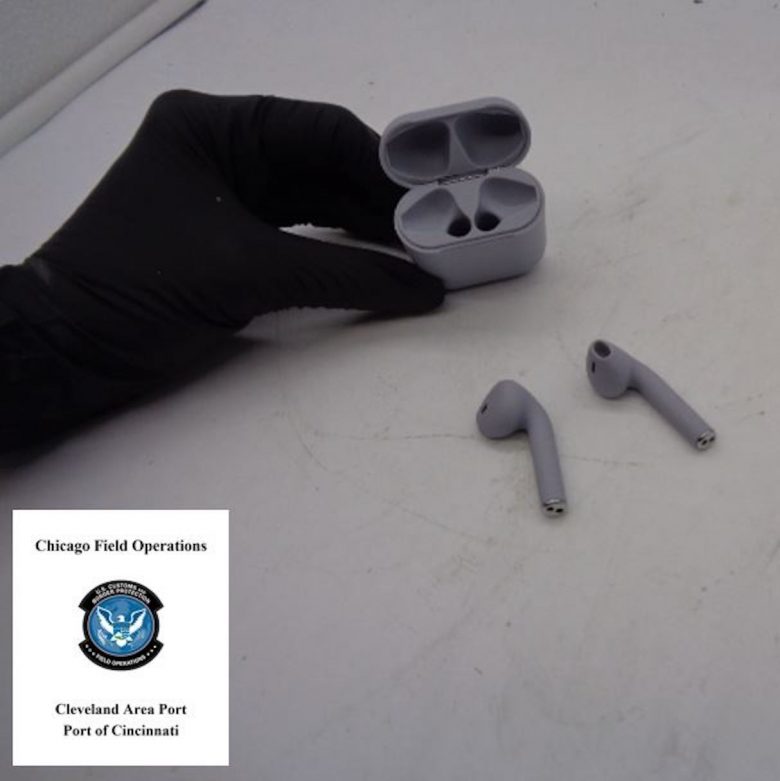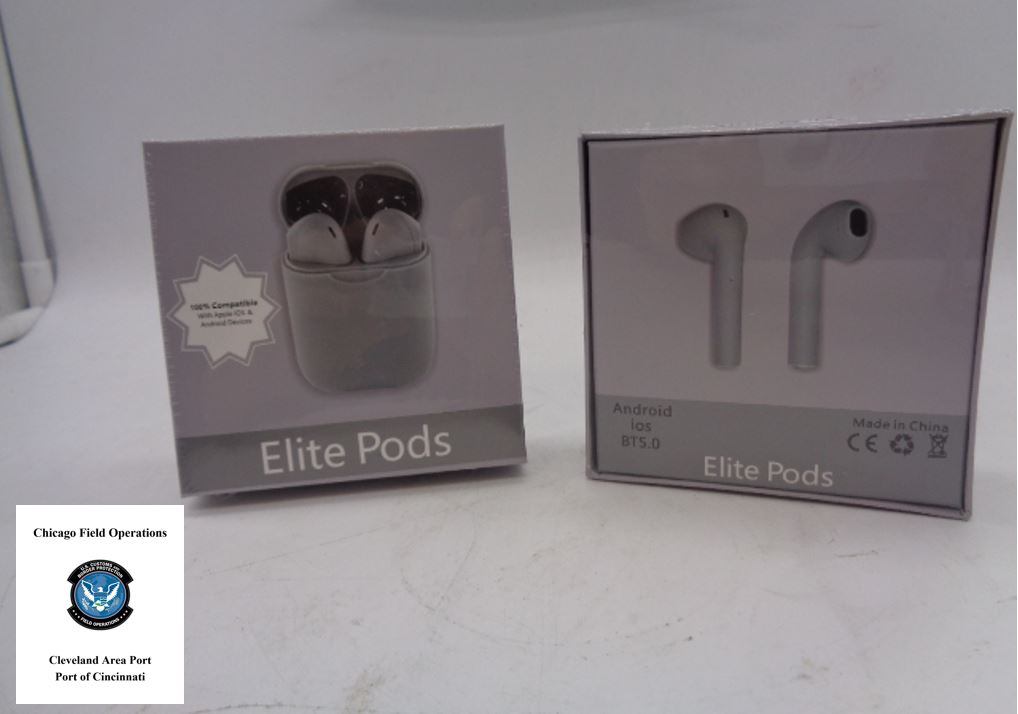When you think about the types of items typically seized by U.S. Customs and Border Protection, you might picture contraband like drugs or weapons. You probably don’t imagine knockoff AirPods as a target.
In fact, bogus earbuds are a big deal. Customs and Border Protection seized “roughly 360,000 counterfeit wireless headphones with a retail value of $62.2 million” since October, according to a story in The Information, citing previously unreported government data.
Apple is one several predominantly larger companies that work with Customs officers to help weed out copycat products upon their entry into the United States. And the counterfeit goods are not necessarily packaged to look exactly like actual Apple products. Here’s how it works.
Checking for trademark violations
“When a shipment is suspected of violating Trademark and Copyright laws, the items in questions are examined by [an] import specialist at several different Centers of Excellence and Expertise,” a spokesperson for U.S. Customs and Border Protection Public Affairs told Cult of Mac via email.
“These import specialists have been trained by industry experts to know what to look for that will authenticate the goods being shipped,” they continued. “We even bring in industry experts to inspect the items on certain occasions. These industry experts in coordination with our import specialist make the determination of whether the goods are authentic or counterfeit.”
While names and logos are the most common trademarks, designs can be trademarked, too. The CBP’s trademark enforcement program allows rights-holders like Apple to record their federally registered trademarks and copyrights so agencies can enforce them at the border. Any inspected package can then be checked to ensure that it doesn’t appear to violate any trademarks belonging to companies. (A similar law regarding patents has also been proposed, but not passed.)
The case of the fake AirPods
After CBP experts inspect shipments, they relay their conclusions to officers who can seize a shipment or let it through to its destination. Information about every item seized goes to Homeland Security Investigations, the investigating arm of the Department of Homeland Security. The alleged counterfeit goods then go to a CBP warehouse. Eventually, CBP destroys them.
An example of this took place recently when, U.S. Customs and Border Protection officers in Cincinnati seized “tens of thousands” of what appeared to be AirPods knockoffs. Each case of the seized shipment from China had a declared value of $5,280, and contained 12,000 earbuds. Had they been legit AirPods, the total 36,000 units would have been valued at $7.16 million.

Photo: U.S. Customs and Border Protection
It is not clear quite how many companies participate in this program, and the CBP declined to provide exact numbers. However, the CBP rep said that, as of September last year, Customs enforces 18,757 active recorded copyrights and trademarks for companies. That might sound like a large number, but it’s a drop in the ocean when compared to the 600,000 trademarks filed in the United States last year.
“Not a lot of brand owners take advantage of this program that Customs has,” Josh Gerben, a trademark lawyer and founder of Gerben Intellectual Property, told Cult of Mac. “[As a result it’s] typically the larger companies that are more aware of it — and more likely to take advantage of it.”
Nonetheless, even with this relatively low take-up, the CBP seized 26,503 shipments in 2020 for breaking these rules. Based on the total manufacturer’s suggested retail prices, the value of seized goods stands at more than $1.3 billion.
Cracking down on counterfeit devices
From Apple’s perspective, it makes sense that the company would use every means at its disposal to crack down on the importing of counterfeit devices.
“There are few things more gut-wrenching than spending months or years inventing a new product and turning it into a successful business, only to see a direct knockoff for half the price,” Del Yocam, Apple’s first chief operating officer, told Cult of Mac. “It is an insidious way that many individuals and companies try to harm our industry.”
Apple frames the effort to stop bogus earbuds and other gear as protecting consumers.
“Counterfeit products deliver an inferior experience, and they can often be dangerous,” an Apple spokesperson told The Information. Apple works internationally with law enforcement, customs agents, social media companies and merchants to remove counterfeit products.
“It’s important for customers to have the confidence they are buying a genuine product, and not being tricked into thinking they’re buying something that they’re not,” the Apple rep said.
When fakes aren’t actually fakes
There’s an extra level of complexity, however. In the case of the “fake AirPods” seized by Customs in Ohio, the product is not labeled as an actual Apple product — although they certainly appear to be misleadingly close.
Packaging seen in photos describes the earbuds as “Elite Pods” for Android and iOS. The packaging looks reminiscent of Apple’s, but not the same. The packaging bears no visible Apple logo. Instead, there’s a thick gray band that’s not present on AirPods boxes, and a “Made in China” label rather than Apple’s iconic “Designed by Apple in California” wording.
Trademark lawyer Gerben said there is extra complexity in cases when an item is seized that is not pretending (at least, not directly) to be a genuine product made by another company. While Apple can only have trademarks enforced that it has legally been granted, there is more nuance in cases in which another company might claim that their design is not, in fact, infringing.
Some trademark cases can go on for years in court before arriving at a verdict. Seizure of goods upon entry by Customs can therefore result in false positives.
Owning the ear
“Apple is claiming, basically, that it owns a trademark or trade dress registration around the shape of these AirPods,” Gerben said. “They’re claiming that [a product with a similar shape is] a counterfeit, or that’s an infringement on their trademark. There are certainly valid defenses to that point. [But you could also argue that] there’s certain functionality of this design that you just can’t protect. How many ways you can design something that fits in somebody’s ear?”
Hey, give those back!
— OnePlus➕ (@OnePlus_USA) September 14, 2020
Gerben is speaking hypothetically, rather than specifically defending the makers of Elite Pods. But it is a challenge that other, more established, manufacturers have run into. A similar incident took place last year when U.S. Customs and Border Protection seized shipments of OnePlus Buds. At first it looked like Customs agents mistook the OnePlus Buds for counterfeit AirPods. However, it was later revealed that they had, in fact, been seized because they appeared to “violate Apple’s configuration trademark.”
Cases like this highlight the challenges faced in this area, by Apple, by smaller rival manufacturers and by Customs agents.
With no immediate contact details available for Elite Pods, Cult of Mac contacted OnePlus about the OnePlus Buds confiscation. We received no response from OnePlus. Apple also failed to reply to requests for more information.
Apple has its own dedicated webpage for customers who think they might have received counterfeit goods. It allows users to submit images and other details so Cupertino can crack down on fakes.


